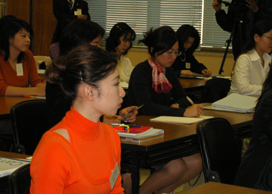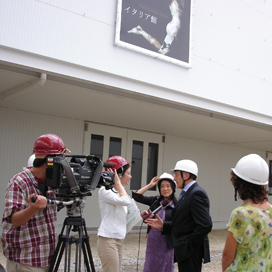“The Art of Living”: the Italian Pavilion opens its doors
September 2004
The Art of Living. This will be the theme of the Italian Pavilion at the Universal Exposition in Aichi. The beauty, art, culture and quality of the Italian lifestyle will be set on display in a unifying setting: the Mediterranean.
In the words of Fernand Braudel the Mediterranean sea “is a thousand things together. Not one landscape, but a thousand landscapes; not one sea, but a succession of seas. Not one civilisation, but a series of interwoven, overlapping civilisations”.

This is the stimulating setting in which the Italian Pavilion will portray the sensations and moods of an age-old civilisation, conveying them to the Japanese public.
The first room is dedicated to the joy of living, Italian vitality. The visitor's interest will be aroused not just by objects or images, but above all by the atmosphere. The elements used are light (a powerful, warm solar light), a large sheet of water, and glass – the glass of the walls, the gangway crossing the sheet of water and the supports used for the objects we shall exhibit, coloured glass of varying transparency selected in such a way as to create a poetic and even oneiric effect. An effect that will impress the visitor as soon as he enters. After this, as he moves further into room along the gangway he will discover objects emerging from the water or suspended in the air and objects on the walls half concealed by the sheets of glass enclosing the walls, like a sequence of brightly coloured theatre wings. He will discover inscriptions projected on the walls and water, as he identifies the sounds and scents that accompany him.
The image that emerges from all this will be the image of a country that is not just history and tradition but modernity and technology. The achievements of Italian enterprises all over the world will in fact be on display. International industries and organisations will be exhibiting their top products, such as Permasteelisa, Ponte sullo Stretto S.p.A., Fiat, Finmeccanica, Piaggio, Nordica, Technogym and CNR (National Research Council) along with Italy's most important research centres.

At the end of the room, once the visitor has soaked in this open, joyous, modern and technological atmosphere, he is ready to enter the “pearl” and experience a different, but equally exciting emotion. After the explosion of light and colour, he finds a gentle, clear blue half-light. At the centre of the 9-metre diameter sphere, illuminated by a cone of light, there is the “Dancing Satyr”, the absolute protagonist, immersed – as it has been for millennia – in the flickering, shifting light of the sea-bottom. This 4th century b.C. statue of inestimable value, which was retrieved by a fishing-boat on the sea-bottom only six years ago, will make the longest journey of its existence to appear at the Expo.
The third room is the room dedicated to Italy's regions with their rich blend of culture and tradition. Their very special contribution will come in the form of a space reserved in the Pavilion and a series of fortnightly events that will highlight the diversity of Italy's regions, offering the image of a united, multiform country. The exhibition itinerary will wind up with a reproduction of the Italian home, a warm, welcoming place that people can recognise all over the world thanks to its modern and functional design. A traditional cafè on the first floor will provide the visitor with a place to rest, offering him yet another chance to appreciate Italian quality and style.
Inside the Expo there will also be an Italian restaurant, where Italy's finest cooks will take turns to offer the Japanese public the most highly refined flavours of Italian and Mediterranean cuisine.
A key event of Italy's participation at the Expo will be the National Day, which will be held on 28 April 2005. On this occasion there will be performances by the Carabinieri Band, which is highly renowned and appreciated throughout the world, and by Roberto Bolle, the star of Milan's La Scala, who will be staging his show together with twelve of Europe's finest dancers.
This will be the image of a Nation portrayed in the framework – the highly evocative framework of the Universal Exposition – of a single theme. The ultimate message of this theme is to show how the quality of Italy's past history is there to serve the quality of the future of all other countries.


